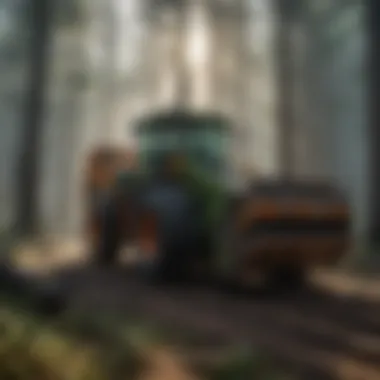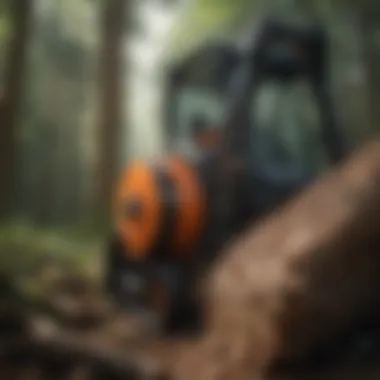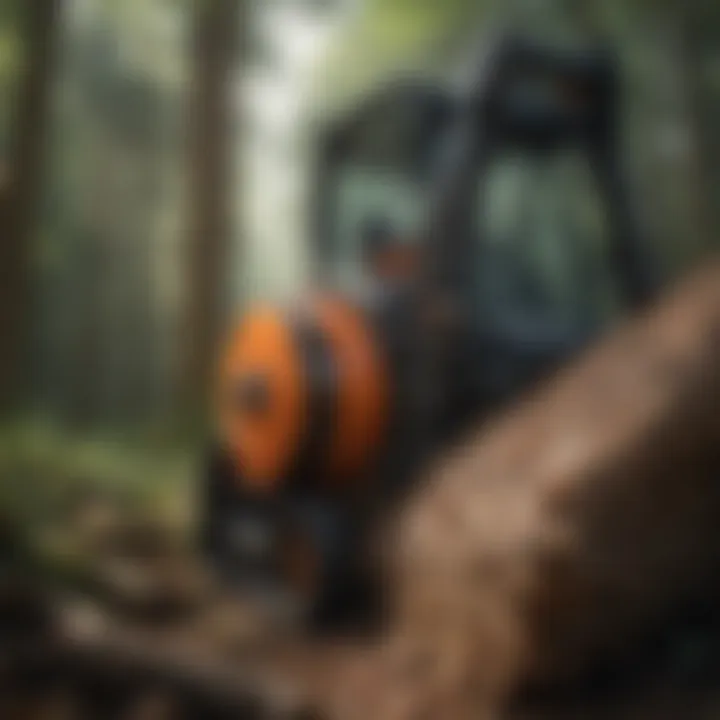Understanding Large Tree Mulchers: Technology and Applications


Intro
In the realm of forestry management, large tree mulchers play a critical role in enhancing sustainability and efficiency. As the need for environmentally responsible practices increases, understanding how these machines function and their applications becomes essential. This section provides an overview of woodland ecosystems, emphasizing the relationship between biodiversity, forest management, and climate regulation.
Understanding Woodland Ecosystems
Importance of Biodiversity in Forests
Biodiversity within woodland ecosystems is vital for numerous reasons. It contributes to the stability and resilience of forest environments. Varied species support interactions that help maintain soil health, water quality, and overall ecosystem functionality. A diverse range of organisms can also assist in pest and disease control. When large tree mulchers are utilized appropriately, they can enhance biodiversity by creating habitats and promoting the growth of various plant species. This allows forests to flourish and adapt to changing environmental conditions.
Role of Forests in Climate Regulation
Forests are significant players in regulating the earth’s climate. They absorb carbon dioxide, which helps mitigate climate change. According to research studies, forests can sequester large amounts of carbon, thereby playing a crucial role in carbon management strategies. Maintaining healthy forest ecosystems through techniques such as mulching can support this essential function. By reducing fire hazards and promoting healthy underbrush, large tree mulchers contribute to more stable forest environments.
"Forests are indispensable for the balance of our planet. They act not only as carbon sinks but also as biodiversity reserves and climate regulators." — Forest Research Institute
Sustainable Forestry Practices
Principles of Sustainable Forestry
Sustainable forestry involves managing forest resources to meet current needs without compromising future generations. Central to this principle is the balance between ecological integrity and economic viability. Practices such as selective logging, reforestation, and mulching ensure that forest ecosystems remain productive and healthy. Large tree mulchers are integral to these practices, as they help in the efficient processing of forest debris while minimizing the disturbance to the underlying ecosystem.
Case Studies of Successful Implementations
Examining successful case studies provides insight into sustainable forestry practices. In regions such as the Pacific Northwest, selective logging combined with mulching has resulted in healthier forest ecosystems. The use of large tree mulchers has allowed for the rapid breakdown of tree waste, aiding in nutrient cycling while preventing soil erosion. These successes highlight the potential of large tree mulchers to support sustainable practices across various forestry applications.
Woodland Stewardship Techniques
Forest Management Plans
Developing effective forest management plans requires a comprehensive understanding of the ecosystem. Key components often include inventory assessments, growth predictions, and prescribed treatments. Large tree mulchers can be included as a tool to manage debris efficiently, assisting in achieving the outlined objectives. Their ability to handle large volumes of material makes them indispensable for practical forestry management.
Conservation Strategies
Implementing conservation strategies is another critical aspect of woodland stewardship. These strategies often focus on protecting key habitats, enhancing ecological resilience, and ensuring sustainable resource extraction. Large tree mulchers can aid in the restoration of degraded sites through debris clearance and facilitating the regeneration of native species. This supports forest health and preserves biodiversity.
In concluding this section, it is clear that large tree mulchers are not merely machines; they embody a broader approach to sustainable forest management. Understanding their role requires a grasp of the interactions within woodland ecosystems and the practices that support healthier forests.
Foreword to Large Tree Mulchers
Large tree mulchers are integral to modern forestry practices. Understanding their technological advancements and varied applications provides critical insights for forestry professionals and relevant stakeholders. These machines offer not only efficiency but also contribute significantly to sustainable land management.
Defining Large Tree Mulchers
Large tree mulchers can be seen as heavy-duty machines designed to process large trees and other woody materials. They effectively reduce oversized wood into smaller, manageable pieces. Typically, these mulchers have powerful engines and robust cutting mechanisms which enable them to handle substantial tree trunks and brush.
The size and configuration of large tree mulchers can vary widely. Some are towed behind trucks, while others are self-propelled. This versatility is crucial in adapting to different forestry environments and project requirements. By redefining waste materials into mulch, they serve a dual purpose: site clearing and resource recycling.
Historical Development of Mulching Equipment
The concept of mulching is not new. The evolution of mulching equipment has progressed significantly since its inception. Early tools were basic and used manual labor, which was both labor-intensive and time-consuming. As the demand for more efficient forestry operations grew, manufacturers began developing mechanized solutions.
In the mid-20th century, the arrival of tractor-mounted mulchers revolutionized the industry. These machines evolved from simple chippers to more complex systems capable of handling larger volumes and tree sizes. The late 20th century saw further refinement with enhanced engine technologies, allowing for increased power and productivity. Today, we can observe a diverse range of large tree mulchers equipped with cutting-edge technology, facilitating more effective forest management operations.
Advancements continue to emerge, making these machines indispensable in both commercial forestry and environmental conservation efforts. Their role in maintaining forest health and supporting sustainable practices has never been more relevant than in today's context of climate change and biodiversity loss.
Key Components of Large Tree Mulchers
Understanding the key components of large tree mulchers is essential for anyone involved in forestry management or equipment operation. These components not only dictate the efficiency of the machine but also its suitability for specific tasks. Each part plays a critical role in the overall functionality of the mulcher, impacting its performance and maintenance needs.
Engine Specifications
The engine serves as the heart of a large tree mulcher. It is responsible for generating the power needed to perform demanding tasks. Commonly found engines range from diesel to high-performance gasoline types. Diesel engines are preferred in many professional settings because they offer better torque and fuel efficiency. Key specifications to consider include horsepower, fuel type, and emission standards. Additionally, noise levels should not be overlooked, as quieter engines may benefit operators in sensitive environments.
Cutting Mechanism
The cutting mechanism is a pivotal component of large tree mulchers. It determines how effectively the machine can process wood debris. There are several designs, including drum cutters and disc-style cutters. Drum cutters often provide more consistent performance over varied material types, while disc cutters can manage large branches better. The materials used for blades and their geometry also affect cutting efficiency and durability. Regular maintenance of cutting components is crucial to ensure the longevity and performance of the machine.
"Properly maintained cutting mechanisms offer unique benefits, such as reducing downtime and enhancing processing speed."


Frame and Chassis Construction
The frame and chassis construction provide the structural integrity necessary for the mulcher’s operations. Strong materials, like high-strength steel, are commonly used to withstand impacts and the stress of heavy workload. The design of the chassis can also influence mobility and stability, especially on uneven terrain. It's important to evaluate factors like weight distribution and the placement of support beams. Additionally, heavy-duty wheels or tracks can improve traction and control during operation. Ensuring a robust design allows for better performance in diverse working conditions.
Operational Processes of Large Tree Mulchers
The operational processes of large tree mulchers are crucial to their effectiveness and efficiency in forest management. Understanding these processes enables forestry professionals to utilize mulching equipment more proficiently, resulting in better resource management and environmental sustainability. Efficiency in preparation, execution, and post-operation management enhances the overall performance of mulching projects, aligning with sustainable forestry practices.
Preparation for Mulching Operations
Preparation is a key phase in any mulching operation. Correct steps must be taken before deploying large tree mulchers to ensure safety and maximize efficiency. The first step involves assessing the area where mulching will take place. Factors such as terrain, tree density, and vegetation type inform the decision on the best equipment and techniques to employ.
Additionally, site survey is crucial. This includes identifying any potential hazards, such as power lines, unstable ground, or wildlife habitats. Pre-operation planning should also involve determining the size and type of trees to be mulched, which can impact equipment settings and the operator's approach.
Operators should also ensure that all necessary personal protective equipment is ready and that the mulcher is thoroughly inspected before operation. Safety checks can help prevent accidents and equipment failures during the process. This preparation phase significantly influences the success of the entire operation.
Mulching Techniques and Strategies
Mulching techniques vary depending on the specific goals of the operation. There are different approaches to mulching that professionals may choose from, each with its advantages and applications. One common technique is dynamic mulching, where large pieces of wood are fed into the machine to be shredded effectively.
Another technique is selective mulching, which targets specific tree species or areas while leaving others intact. This method can enhance habitat conservation by preserving biodiversity and promoting healthy tree growth. Understanding the different mulching strategies allows operators to align their activities with both their operational goals and wider sustainability objectives.
For effective execution, mulchers often utilize adjustable settings. Operators should be familiar with their equipment's features, such as cutting speed, and depth adjustments, to optimize the mulching process according to varying conditions.
Post-Mulching Site Management
After the mulching operation, management of the site is vital. The mulched area must be assessed for its impact on the ecosystem. Post-operation checks include monitoring soil conditions and assessing the mulched debris's distribution. Mulched material can be used to improve soil fertility, but excessive leftover material may impede new growth.
Furthermore, plan for potential follow-up activities, such as additional planting or restoration efforts. Proper management ensures that the mulching process benefits the environment rather than hindering it. It's also essential to document the process and any challenges encountered to improve future operations.
"Effective operational processes not only enhance performance but also contribute to sustainable forestry objectives."
Benefits of Using Large Tree Mulchers
Large tree mulchers provide numerous advantages, particularly in the context of sustainable forestry management. These benefits extend beyond mere efficiency; they significantly contribute to ecological health, biodiversity, and forest floor management. By considering these factors, forestry professionals can make informed decisions regarding the use of mulching equipment in their projects.
Enhancing Forest Health
The use of large tree mulchers can significantly enhance overall forest health. By reducing the density of trees and underbrush, these machines allow sunlight to reach the forest floor. This promotes the growth of a variety of plants, which are essential for a balanced ecosystem. Additionally, mulching helps in nutrient cycling. Instead of removing trees entirely, the mulcher breaks down organic material, returning it to the soil. This not only enriches the ground but also preserves moisture levels, making it easier for new growth to thrive.
Promoting Biodiversity
Biodiversity is crucial for robust ecosystems. Large tree mulchers indirectly support this by creating a more varied habitat for wildlife. Areas that undergo mulching become havens for different species of plants and animals. The cleared space encourages the growth of various flora, which, in turn, attracts a diverse range of fauna. Studies have shown that mulched areas often harbor greater species richness and contribute to a balanced ecosystem.
Reducing Forest Floor Fuel Load
One of the pressing concerns in forest management is the buildup of fuel loads on the forest floor. Large tree mulchers effectively address this issue by converting excess vegetation into mulch. This practice not only minimizes the risk of wildfires but also promotes healthy soil. The reduction of dense underbrush decreases fire hazards, thereby protecting both ecosystems and human settlements. Moreover, maintaining a balanced forest floor supports moisture retention, contributing positively to the environment.
The benefits of using large tree mulchers in forestry are vast, including improved forest health, a boost in biodiversity, and reduced fire risks. These advantages make them essential tools in modern forestry practices.
Challenges Associated with Large Tree Mulchers
Understanding the challenges associated with large tree mulchers is critical for forestry professionals. While these machines provide significant benefits for efficient wood processing, recognizing their limitations ensures better decision-making and operational safety. Exploring these challenges highlights the complexities behind their use and helps mitigate potential drawbacks.
Labor and Equipment Costs
Investing in large tree mulchers requires substantial financial commitment. The initial purchase price of a mulcher can be high, and this does not only include the equipment itself. There are additional costs related to maintenance, repairs, and operational expenses that can accumulate over time.
- Labor Costs: Skilled operators are necessary for efficient operation. Employing trained professionals adds to the overall expense. The cost of labor is also affected by the nature of the work, which can be physically demanding and requires specific expertise.
- Maintenance and Repair: Regular maintenance is essential to ensure optimal functioning. This involves routine checks, replacement of worn parts, and addressing any mechanical issues. High-quality parts can be costly, especially for models that are specialized or not commonly used.
- Fuel: Larger mulchers consume considerable amounts of fuel, which raises operational costs, especially in prolonged projects.
In summary, while large tree mulchers enhance efficiency, the financial implications can be significant and need careful evaluation before deployment.
Environmental Concerns
The operation of large tree mulchers is not without its environmental implications. Despite their efficiency, mulchers can pose environmental risks that must be carefully managed.
- Soil Disturbance: Heavy machinery can lead to soil compaction, which adversely affects forest health. Compacted soil restricts water absorption and can harm root systems.
- Biodiversity Impact: The indiscriminate clearing of trees may simplify ecosystems. While mulching can be beneficial for certain species, it may also endanger others by removing critical habitat.
- Air Quality: Smoking machinery can contribute to air pollution. Monitoring emissions is vital to mitigate this concern.
Experts emphasize the importance of implementing eco-friendly practices alongside the use of large tree mulchers to minimize their environmental footprint. Awareness of these aspects can foster more sustainable forestry management.


Operational Limitations
Operational limitations can significantly affect the effectiveness of large tree mulchers. Understanding these constraints aids in strategic planning and optimal usage.
- Access Challenges: These machines may not have access to all areas within a forest due to terrain and size constraints. Some locations may be inaccessible or require additional equipment to reach.
- Variable Wood Types: Different tree species present unique challenges. Hardwoods or particularly dense trees can cause increased wear on blades and require more maintenance and fuel.
- Seasonality: Weather conditions can impact operational efficiency. Wet or muddy conditions can hinder operations and lead to potential equipment damage.
In summary, recognizing these various limitations is vital for crafting effective strategies for mulching operations. This understanding guides users in making informed choices regarding equipment and practices.
Safety Considerations in Tree Mulching
In the realm of forestry, safety considerations during tree mulching are paramount. The equipment used in these operations can be powerful and potentially dangerous if not handled properly. Ensuring that safety is at the forefront of any mulching activity protects not only the operators but also the surrounding environment and personnel. Compliance with safety regulations can minimize the risk of accidents and injuries, creating a safer working space.
Key elements that contribute to safety include proper training, use of the right protective gear, and adherence to operational protocols. By understanding these aspects, forestry professionals can carry out their work with confidence and competence while maintaining a strong focus on safety.
Personal Protective Equipment
Personal Protective Equipment, commonly known as PPE, plays a crucial role in ensuring the safety of individuals operating large tree mulchers. The selection and use of appropriate PPE are fundamental for reducing injury risks. Some essential items of PPE include:
- Helmets: They protect against falling objects and debris. A hard hat can significantly reduce the risk of head injury.
- Safety Goggles: Eyes can be vulnerable to flying particles. Using goggles helps to shield the eyes from dust and debris.
- Ear Protection: Mulchers can produce high noise levels that may lead to hearing damage. Ear plugs or earmuffs are important for operators.
- Gloves: Durable gloves protect hands from sharp edges and provide grip while operating the machinery.
- Steel-Toed Boots: These boots protect the feet from accidents associated with heavy machinery while providing necessary support.
Using these items correctly can lessen the potential for injuries on the job. Operators should also inspect their PPE regularly to ensure it's in good condition.
Operational Safety Protocols
Operational safety protocols are designed to guide operators through safe practices while using large tree mulchers. Following these protocols fosters a culture of safety on the job site. Key protocols include:
- Pre-Operational Checks: Operators should conduct a thorough inspection of the mulcher before use. This includes checking for leaks, ensuring all guards are in place, and inspecting for any damage.
- Training and Certification: Comprehensive training programs on proper equipment usage, maintenance, and emergency procedures are essential. Operators should be certified to ensure competence.
- Communication: Maintaining clear communication with team members during operations prevents misunderstandings. Using hand signals or radios can enhance safety.
- Emergency Procedures: Knowing how to respond in case of an accident is critical. Operators should be trained in first aid and have a plan in place for emergencies.
- Limitations: Operators need to understand the limitations of their equipment and avoid pushing the mulcher beyond its capabilities. Overloading or using it improperly can lead to malfunctions and accidents.
Proper safety measures are not just a regulatory requirement; they are a best practice that protects lives and property.
By embracing these safety considerations, forestry professionals can effectively mitigate risks associated with large tree mulching operations. The implementation of proper PPE and adherence to operational protocols can significantly enhance the safety and efficiency of mulching practices.
Maintenance and Care for Large Tree Mulchers
Maintenance and care for large tree mulchers is a critical aspect that directly impacts their efficiency and longevity. Keeping these machines in good working order not only ensures optimal performance but also contributes to safety and the overall success of mulching operations. Regular maintenance helps prevent unexpected breakdowns, which can lead to costly repairs and project delays. Understanding the maintenance requirements can equip forestry professionals with essential knowledge for effective machine operation.
Routine Maintenance Practices
Routine maintenance for large tree mulchers involves a series of regular checks and operations. The following practices are essential:
- Daily Inspections: Each day before use, the operator should inspect the machine for visible signs of wear or damage. Check for leaks in hydraulic systems and ensure that all safety guards are in place.
- Lubrication: Proper lubrication of moving parts is vital. Apply lubricant to components such as bearings, pins, and hinges to prevent friction and reduce wear.
- Cleaning: Keeping the mulcher clean is important for optimal performance. Remove debris, dirt, and organic material from the machine after operations. This prevents premature wear and helps in diagnosing issues.
- Filter Checks: Regularly checking and replacing the air and fuel filters will ensure that the engine runs smoothly and efficiently. Clogged filters can severely impair performance.
- Fluid Levels: Regularly monitor fluid levels in the hydraulic system, coolant system, and oil reserves. Maintaining proper fluid levels prevents overheating and operational disruptions.
By adhering to these practices, operators can significantly extend the lifespan of their equipment and enhance productivity in the long term.
Identifying Component Wear and Tear
Identifying wear and tear on large tree mulchers is fundamental to effective maintenance. Operators should be trained to observe specific signs that indicate components may need repair or replacement:
- Blades and Cutting Tools: Dull or damaged blades can reduce efficiency. Regular examination of the cutting tools is necessary. Look for chips, cracks, or unusual deformities.
- Hydraulic Hoses and Connections: Inspect hydraulic hoses for abrasions or leaks. High pressure can stress these components, leading to failure.
- Engine Performance: Any changes in engine sound or operation can indicate internal issues. Listen for inconsistencies, which might suggest an impending mechanical failure.
"A proactive approach to maintenance can prevent minor issues from escalating into major failures."
- Tires and Tracks: For tracked mulchers, examine the tracks for cracks and wear. For wheeled models, check for even tire wear, which can indicate alignment problems.
By routinely monitoring these aspects, operators can pinpoint potential problems early and address them, rather than facing downtime during critical mulching seasons.
Selecting the Right Large Tree Mulcher
Choosing the appropriate large tree mulcher for specific forestry tasks is critical. An ill-suited machine can lead to inefficiency, increased costs, and suboptimal results. Each project may have unique requirements that dictate the selection process. This section will explore essential elements such as project needs, manufacturer specifications, and a thorough cost-benefit analysis to facilitate informed decision-making.
Assessing Project Needs
Effective project assessment is the first step in selecting a tree mulcher. Different projects require unique capabilities. For example, a large-scale land clearing operation versus maintaining a park demands different mulching power, size, and mobility features. Here are some factors to consider:
- Type of vegetation: Understand the kinds of trees and underbrush that will be mulched. Softwoods differ from hardwoods in terms of density and resistance.
- Area size: Determining the size of the area to be mulched influences the capacity and size of the machine needed.
- Terrain: The machine's capabilities will vary based on whether the area is steep, flat, or rocky.
- End goals: Identifying whether the mulched material will be utilized for biomass, erosion control, or simply passed on can guide the technical specifications.
Taking time in this stage can prevent additional costs related to system misalignment and operational delays.
Evaluating Manufacturer Specifications


After determining the project's needs, the next step involves carefully evaluating different manufacturers and their specifications. Strong manufacturers often provide detailed documentation describing their mulchers. Specific criteria to focus on include:
- Power and performance: Look for engine specifications that match project demands. Some tasks may require more horsepower.
- Cutting mechanisms: Different mulchers come with various cutters—some are designed for lighter materials, while others can handle thicker trunks.
- Durability and maintenance: Assess the build quality and the accessibility of components for future maintenance.
- Safety features: Review operational safety attributes, such as emergency shut-off and protective covers.
Reading reviews, checking customer testimonials, and possibly contacting users within the industry can provide insight into real-world performance.
Cost-Benefit Analysis
Lastly, conducting a cost-benefit analysis is vital. This process involves evaluating both upfront and long-term operational costs against the expected benefits. Key aspects include:
- Initial cost: Assessing how much the machine will cost initially allows budget planning.
- Operating costs: Consider ongoing expenses such as fuel consumption, parts, labor, and maintenance.
- Longevity and resale value: Durable machines that offer good resale value can make an initial high cost more reasonable.
- Efficiency gains: Improved processing speed and reduced labor requirements can offset initial expenses over time.
"Investing time in a comprehensive selection process can yield significant long-term savings and productivity gains."
Innovations in Tree Mulching Technology
The field of tree mulching is evolving rapidly, driven by advancements in technology and a heightened awareness of environmental sustainability. The integration of innovative technologies not only enhances the efficiency of large tree mulchers but also aligns their operation with best practices in forest management. These innovations have significant implications for forestry professionals and environmental advocates alike, as they contribute to more responsible land stewardship and improved resource management.
Automation and Robotics in Mulching
The incorporation of automation and robotics into tree mulching represents a paradigm shift in how mulching operations are conducted. Automated systems can significantly increase productivity, allowing operators to cover larger areas in less time. Smart systems equipped with sensors can monitor the terrain and adjust the mulching process in real-time, enhancing precision and reducing material waste.
Moreover, robotic mulchers reduce labor requirements, particularly in remote or hazardous terrains where human presence may be risky. By minimizing the need for manual intervention, these technologies not only enhance safety but also lower overall operational costs.
Integration with Eco-Friendly Practices
The adoption of eco-friendly practices is crucial for ensuring the sustainability of forestry operations. Innovations in tree mulching technology emphasize the importance of maintaining ecological integrity during mulching processes. Modern mulchers are designed to minimize soil disturbance and preserve the underlying biodiversity.
Utilizing mulch as a natural soil conditioner is one of the notable benefits of eco-integrated technologies. This practice fosters nutrient recycling and promotes the health of forest ecosystems. Further, many contemporary mulching machines are manufactured with recyclable materials, reducing their environmental footprint.
Innovations in large tree mulchers are not merely technological enhancements; they represent a commitment to sustainable forestry practices that benefit both the environment and the economy.
Efforts to align tree mulching with eco-friendly practices promise long-term benefits for both the forestry sector and the surrounding communities. By adopting practices that prioritize environmental sustainability, forestry professionals can contribute to the health of ecosystems while achieving their operational goals.
Case Studies of Successful Mulching Projects
Case studies of successful mulching projects offer critical insights into the practical applications and benefits of large tree mulchers. They illustrate real-world scenarios where mulching technology has played a significant role in forest management and environmental restoration. Evaluating these case studies helps forestry professionals understand the effectiveness of different techniques and strategies used in various situations. Additionally, they serve to highlight benefits such as cost-efficiency, ecological improvement, and community engagement. The lessons learned from these projects can guide future initiatives and promote best practices in the field of sustainable forestry.
Community-Based Forestry Initiatives
Community-based forestry initiatives demonstrate how local stakeholders engage in sustainable forest management using large tree mulchers. These projects often focus on involving the community in decision-making, resource management, and benefits-sharing.
A notable case can be found in several rural areas where community members collaborated with forestry professionals to clear invasive species. Large tree mulchers allowed them to quickly remove unwanted vegetation, thereby promoting native plant regrowth. This initiative not only helped restore the local ecosystem, but it also offered educational opportunities for community members about sustainable practices.
Furthermore, these initiatives also provide economic benefits. Engaging local labor for mulching projects means job creation, which spurs local economies. The results often yield a landscape that enhances biodiversity while supporting livelihoods. Some of these projects have attracted funding and partnerships, facilitating even more sustainable practices in forestry management.
Restoration Efforts through Mulching
Restoration efforts through mulching represent a strategic approach to rehabilitating degraded ecosystems. Large tree mulchers are instrumental in these efforts, enabling quicker and more effective land management.
For example, a project in a deforested region utilized large tree mulchers to clear spaces for replanting native trees. The efficient removal of existing biomass made way for new growth, helping restore the site to its natural state far faster than traditional methods. This not only improved the forest's health but also revived habitats for local fauna.
Moreover, these restoration projects often benefit from collaboration with environmental organizations. By pooling resources and knowledge, they manage to maximize the positive effects on the landscape. The results frequently include improved soil health, water quality, and overall biodiversity.
"Restoration through mulching showcases how heavy machinery can marry efficiency with environmental goals, yielding significant ecological benefits."
Through these case studies, it is clear that large tree mulchers are more than just machines; they are tools that facilitate collaboration between communities and environmental goals. Understanding their role in specific projects helps professionals in forestry refine their practices and contribute to sustainability.
Future Trends in Large Tree Mulching
The domain of large tree mulching is evolving, driven by technological advancements and a heightened awareness of sustainable practices. Understanding these trends is critical as they affect operational efficiency, environmental responsibility, and the longevity of forest ecosystems. This section explores key elements like engine technology advancements and alignment with sustainable development goals, emphasizing their significance in contemporary forestry.
Advancements in Engine Technology
Recent improvements in engine technology are shaping the future of tree mulching. Current trends show a shift toward engines that are not only more powerful but also more environmentally friendly. These engines are designed to increase efficiency while reducing emissions, aligning with global efforts to combat climate change.
- Increased Efficiency: Newer engine designs allow for higher fuel efficiency, which directly reduces the operating costs of mulching equipment.
- Lower Emissions: Innovations in emission control technologies minimize the environmental impact. This ensures compliance with stricter regulations on air quality and sustainability.
- Enhanced Durability: Modern engines are built to endure rigorous operating conditions, therefore extending the lifespan of mulching machinery.
By integrating these technological advancements, operators can not only achieve better performance but also contribute to sustainable forestry goals.
Sustainable Development Goals in Forestry
Aligning large tree mulching with sustainable development goals is becoming increasingly important. The forestry industry faces pressures to ensure practices not only benefit timber production but also protect ecosystems and biodiversity. Understanding these goals can help shape responsible mulching operations.
- Goal 15: Life on Land: Promotes sustainable management of forests. Mulching can help achieve this by enhancing soil quality and promoting growth of vegetation.
- Funding for Eco-Friendly Initiatives: Many forestry projects are now required to submit plans that align with sustainable practices. This can include the use of advanced mulching techniques that minimize disturbance to the native flora and fauna.
- Community Engagement: Projects that incorporate local input and concerns ensure that mulching practices respect traditional land use. This leads to better acceptance and collaboration within communities.
Historically, forestry practices have often focused on productivity at the expense of sustainability. Future trends aim to integrate economic and environmental considerations on equal footing in mulching operations.







